2020 Annual Report for: Sesiidae / Sesiinae
For species seen in 2020 that had less than or equal to 100 records, full details are included; for more common species, the earliest, latest and highest count by vice-county are shown. The narrative for each species is taken from the main Hantsmoths website, and it is possible that some information on abundance and occurrence can get out of date, as it is impossible to keep up with all changes; however it should give a good introduction to each species. The tables in each species account summarise the previous status, and that for the current year.
For the maps, all records prior to 2020 are shown by a blue dot (the larger the dot, the more recent), with the current year's records shown in red. As previous records are superimposed on any report for 2020, new sites have greater emphasis (i.e. will show as 'more red').
In the species accounts, an asterisk next to a location indicates a new 10km square record; earliest ever dates are highlighted in orange, and latest ever in red. Initials in the species accounts refer to the recorders listed here. Please get in touch if you identify any omissions or errors, in particular if you have records that have yet to be submitted. Details of how to submit records can be found here.
52.002 [B&F: 0370] Hornet Moth Sesia apiformis (Clerck, 1759) - Nb
Nationally scarce (Nb) in open areas with scattered trees in central and southern England, though also recorded from Durham and north and south Wales; local in Ireland with scattered records from a few eastern and southern counties (MBGBI Vol 2). In Hampshire known from only a handful of sites, notably at Chilbolton, where known for many years. Not recorded from the Isle of Wight to date. Wingspan 33-46 mm. Day-flying. Mainly recorded in the larval form, but the early stages are difficult to find during the winter months and the species' true distribution remains largely unknown; the use of the HOR pheromone lure is expanding our knowledge of the true distribution of this spectacular insect. Larva feeds within wood of Black Poplar and other poplars, over-wintering two or three times.
Records prior to 2020
| Vice County | #Records | #Individuals | First Record | Last Record |
|---|---|---|---|---|
| 11 | 2 | 0 | 2008 | 2008 |
| 12 | 15 | 28 | 1951 | 2019 |
2020 records
| Vice County | #Records | #Individuals | Max Quantity |
|---|---|---|---|
| 11 | 1 | 1 | 1 |
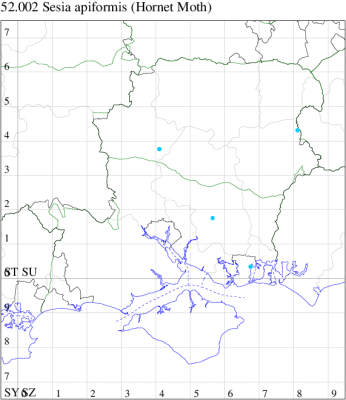
Records by year
Records by week (adult)
Records by week (larval)
Record Details
VC11: Stanford in the Vale*, one, field observation, 28 Jun (SWod)
52.003 [B&F: 0371] Lunar Hornet Moth Sesia bembeciformis (Hübner, [1806]) - Common
Common in fens, woodland, heaths, moorland and hedgerows throughout much of the British Isles, with most records in central and southern England. In Hampshire fairly well distributed, but apparently rare in the central half of northern Hampshire and the eastern quarter of southern Hampshire; also sparsely distributed on the Isle of Wight. Wingspan 32-42 mm. Day-flying. Mainly recorded in the larval form, but the early stages are not easy to find during the winter months; attempts to synthesise an artificial pheromone have so far proved only partially successful. Larva feeds within wood of Sallow, Poplar and Willow, over-wintering twice.
Records prior to 2020
| Vice County | #Records | #Individuals | First Record | Last Record |
|---|---|---|---|---|
| 10 | 9 | 4 | 1900 | 2017 |
| 11 | 70 | 20 | 1960 | 2018 |
| 12 | 33 | 11 | 1951 | 2019 |
2020 records
| Vice County | #Records | #Individuals | Max Quantity |
|---|---|---|---|
| 10 | 2 | 3 | 2 |
| 11 | 20 | 37 | 5 |
| 12 | 4 | 2 | 1 |
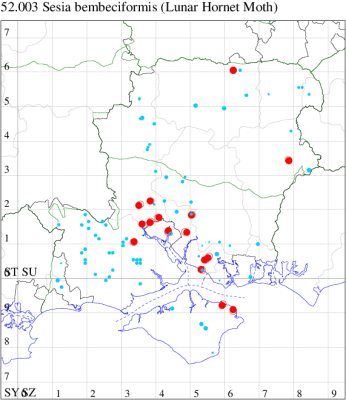
Records by year
Records by week (adult)
Records by week (larval)
Record Details
VC10: Ryde, one, field observation, 11 Jul (JGau det. JBa); Seaview*, two, field observation, 08 Jun (PDyk det. JBa);
VC11: Ashurst, NF, five, to pheromone lure, lUN lure, 06 Jul (SAB); Nursling Substation, one, to pheromone lure, 10 Jul; Southampton, three, to pheromone lure, 18 Jul (JClx); Romsey, one, to pheromone lure, to LUN lure, 20 Jul (SC); one, to pheromone lure, to LUN lure , 08 Jul (NRJ); Chilworth Common, one, to pheromone lure, 22 Jul (JClx); St Denys, Southampton, one, field observation, 17 Jun (CTo det. MGP); Southampton, one, to pheromone lure, 12 Jul (MEdg); Wildern LNR, larva, three, field observation, 03 Jul (SFo); Fair Oak, Eastleigh, one, field observation, 10 Jul (iNat); Eastleigh, five, to pheromone lure, 06 Jul (KArb); Titchfield Haven NNR, one, 11 Jul (DAS); Titchfield, one, to pheromone lure, 06 Jul; Catisfield, one, to pheromone lure, 12 Jul (ALR); Fair Oak, five, to pheromone lure, to LUN lure, 14 Jul; two, to pheromone lure, to LUN lure, 23 Jul (SI);
VC12: Andover, larval feeding signs, present, field observation, lots of larval working where sallows cut down, 26 Dec (TJN, LF); Pamber Forest, one, to pheromone lure, to LUN lure, 16 Jul (GJD); Whitehill*, one, to pheromone lure, 11 Jul (ASto)
52.006 [B&F: 0375] White-barred Clearwing Synanthedon spheciformis ([Denis & Schiffermüller], 1775) - Nationally Scarce
Nationally scarce (Nb) in heathland, marshes, river-banks and damp woodland in southern and central England, northwards to Yorkshire, and north and south Wales. In Hampshire mostly restricted to the extreme north and east of vice-county 12 (north Hampshire), while in vice-county 11 (south Hampshire) the species is recorded from Emer Bog and Chandler's Ford. Not recorded from the Isle of Wight to date. Wingspan 26-31 mm. Day-flying. The early stages may be sought during the winter months, but synthetic pheromone lures are used to attract males nowadays, and this has led to a marked increase in records of the species in recent years. Larva feeds within wood of Alder, Silver Birch and Downy Birch, over-wintering two or three times.
Records prior to 2020
| Vice County | #Records | #Individuals | First Record | Last Record |
|---|---|---|---|---|
| 11 | 6 | 3 | 1800 | 1994 |
| 12 | 49 | 87 | 1800 | 2019 |
2020 records
| Vice County | #Records | #Individuals | Max Quantity |
|---|---|---|---|
| 12 | 3 | 10 | 5 |
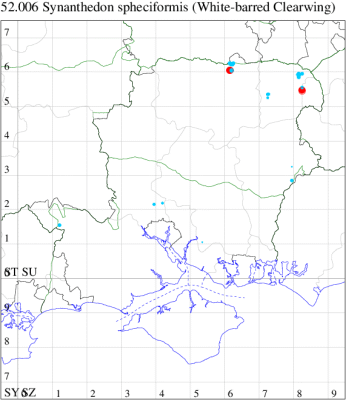
Records by year
Records by week (adult)
Records by week (larval)
Record Details
VC12: Pamber Forest, three, to pheromone lure, 28 May (GJD); Pamber Heath, two, to pheromone lure, 26 May (PCus); Fleet Pond, five, netted, 25 May (MHals)
52.007 [B&F: 0381] Large Red-belted Clearwing Synanthedon culiciformis (Linnaeus, 1758) - Nationally Scarce
Nationally scarce (Nb) in heaths and open woodland in parts of the British Isles. In Hampshire locally common in the north-east and around the New Forest. Not recorded from the Isle of Wight to date. Wingspan 22-25 mm. Day-flying, the earliest clearwing to emerge in spring. The early stages may be sought during the winter months, but synthetic pheromone lures are used to attract males nowadays, and this has led to a marked increase in records of the species in recent years. Larva feeds within bark of Silver Birch, Downy Birch and Alder, making characteristic tunnels under the bark of birch trees and stumps.
Records prior to 2020
| Vice County | #Records | #Individuals | First Record | Last Record |
|---|---|---|---|---|
| 11 | 23 | 24 | 1951 | 2018 |
| 12 | 43 | 160 | 1951 | 2018 |
2020 records
| Vice County | #Records | #Individuals | Max Quantity |
|---|---|---|---|
| 11 | 1 | 1 | 1 |
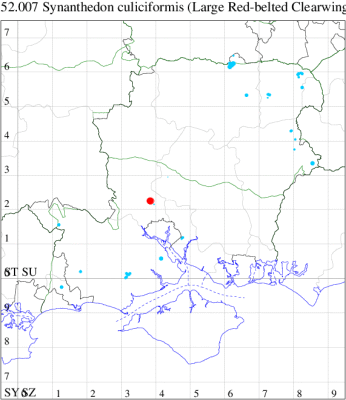
Records by year
Records by week (adult)
Records by week (larval)
Record Details
VC11: Romsey, one, to pheromone lure, to CUL lure, 19 May (NRJ)
52.008 [B&F: 0380] Red-tipped Clearwing Synanthedon formicaeformis (Esper, 1782) - Nb
Nationally scarce (Nb) in fens, marshes, river-banks, damp areas, gravel pits and ponds in southern England, northwards to Dumfriesshire, and southern Wales; rare in Ireland. In Hampshire found in small numbers in suitable habitat in both the north and south of the county, and probably under-recorded; the same is true of the Isle of Wight, where it was first found in 2015 but has been annual since. Wingspan 17-19 mm. Day-flying. The early stages may be sought during the winter months, but synthetic pheromone lures are used to attract males nowadays, and this has led to a marked increase in records of the species in recent years. Larva feeds within stems and wood of Osier, Willow and Sallow.
Records prior to 2020
| Vice County | #Records | #Individuals | First Record | Last Record |
|---|---|---|---|---|
| 10 | 8 | 50 | 2015 | 2019 |
| 11 | 42 | 65 | 1978 | 2019 |
| 12 | 27 | 55 | 2004 | 2019 |
2020 records
| Vice County | #Records | #Individuals | Max Quantity |
|---|---|---|---|
| 10 | 5 | 15 | 5 |
| 11 | 13 | 22 | 4 |
| 12 | 4 | 5 | 2 |
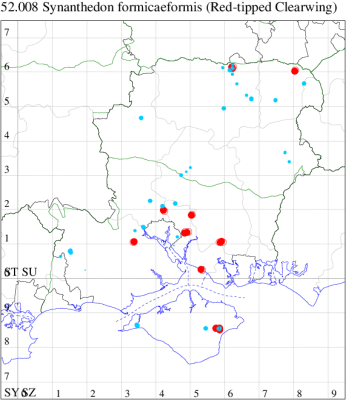
Records by year
Records by week (adult)
Records by week (larval)
Record Details
VC10: Alverstone, two, to pheromone lure, to FOR lure, 15 Jun (IOu); Sandown, one, field observation, 16 Jul (SWhi det. IOu); five, to pheromone lure, to FOR lure, 15 Jun (IOu);
VC11: Blashford Lakes, four, field observation, 11 Jun (DAS); Ashurst, NF, one, to pheromone lure, 15 Jun (SAB); Chandlers Ford, one, indoors, 15 Jun (AMu); Southampton, one, to pheromone lure, 12 Jul (MEdg); Wildern LNR, one, field observation, 08 Jun; one, field observation, 06 Jul (TCr); Eastleigh, two, sugaring, 21 Jun (KArb); Titchfield Haven NNR, one, 11 Jul (DAS); Fair Oak*, one, to pheromone lure, to FOR lure, 25 Jun (SI); Wickham Common*, four, to pheromone lure, 20 Jul; two, to pheromone lure, 21 Jul (KC); two, 11 Jul (DAS);
VC12: Lower Inhams Copse, Pamber, two, to pheromone lure, to FOR lure, 02 Jun; one, to pheromone lure, to FOR lure, 21 Jul; Silchester Brook, one, to pheromone lure, to FOR lure, 21 Jul (GJD); Yateley*, one, to pheromone lure, to FOR lure, 02 Jun (JHH)
52.009 [B&F: 0377] Sallow Clearwing Synanthedon flaviventris (Staudinger, 1883) - Nationally Scarce
Nationally scarce (Nb) in damp woodland and heathland in central southern and south-eastern England; adults appear only in even years. In Hampshire where the species was discovered new to Britain in 1926 near Southampton, the galls made by the larva of this species on Grey Sallow Salix cinerea are sometimes locally common in the winters of "even" years, mainly in the south-east of the county, but the insect is often heavily parasitised. There are a few scattered records from the Isle of Wight. Wingspan 17-20 mm. Day-flying. The early stages may be sought during the winter months, but synthetic pheromone lures are used to attract males nowadays, and this has led to a marked increase in records of the species in recent years. Larva feeds within stems of Sallow, over-wintering twice.
Records prior to 2020
| Vice County | #Records | #Individuals | First Record | Last Record |
|---|---|---|---|---|
| 10 | 4 | 1 | 1930 | 2010 |
| 11 | 65 | 39 | 1800 | 2010 |
| 12 | 32 | 54 | 1800 | 2018 |
2020 records
| Vice County | #Records | #Individuals | Max Quantity |
|---|---|---|---|
| 10 | 1 | 1 | 1 |
| 11 | 11 | 31 | 8 |
| 12 | 5 | 6 | 2 |
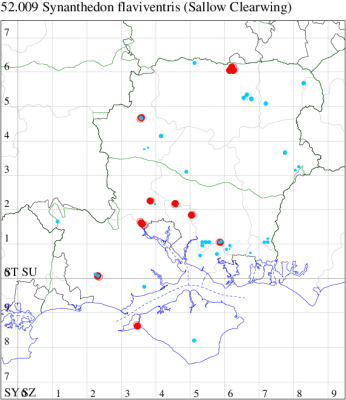
Records by year
Records by week (adult)
Records by week (larval)
Record Details
VC10: Afton Marsh, one, to pheromone lure, to SAL lure, 24 Jul (SDa);
VC11: Holmsley, NF, eight, 18 Jul (DAS); three, field observation, to SAL lure, 12 Jul (PDB); Nursling*, one, 28 Jul (PDW); Nursling Substation*, three, to pheromone lure, sAL lure, 06 Jul; three, to pheromone lure, sAL lure, 06 Jul (JClx); Romsey, two, to pheromone lure, to SAL lure, 11 Jul (NRJ); Allbrook*, three, to pheromone lure, sAL Lure, 11 Jul; Fair Oak, one, to pheromone lure, sAL Lure, 13 Jul (SI); Wickham Common, one, to pheromone lure, 10 Jul; three, to pheromone lure, 13 Jul (KC);
VC12: Anton Lakes, larva, one, field observation, 20 Jul (SFo); Anton Lakes, Hampshire, one, to pheromone lure, to SAL lure, 20 Jul (JRen); Pamber Forest, one, to pheromone lure, to SAL lure, 16 Jul; Lower Inhams Copse, Pamber, one, to pheromone lure, to SAL lure, 21 Jul; Pamber Forest, two, to pheromone lure, to LUN lure, 16 Jul (GJD)
52.010 [B&F: 0378] Orange-tailed Clearwing Synanthedon andrenaeformis (Laspeyres, 1801) - Nb
Nationally scarce (Nb) in chalk downland, limestone grassland and woodland edges in southern England, northwards to Worcestershire. In Hampshire probably found across the central chalk downs, but also found to the north in woodland and urban areas, including around Basingstoke. Surprisingly rare in South Hampshire south of Winchester. Not recorded from the Isle of Wight to date. Wingspan 18-22 mm. Day-flying. The early stages may be sought during the winter months, but synthetic pheromone lures are used to attract males nowadays, and this has led to a marked increase in records of the species in recent years. Larva feeds in the stems and twigs of Wayfaring Tree and less often in Guelder Rose, over-wintering twice. Old galls are conspicuous, but tenanted ones are difficult to see.
Records prior to 2020
| Vice County | #Records | #Individuals | First Record | Last Record |
|---|---|---|---|---|
| 11 | 56 | 52 | 1700 | 2019 |
| 12 | 131 | 310 | 1800 | 2019 |
2020 records
| Vice County | #Records | #Individuals | Max Quantity |
|---|---|---|---|
| 11 | 8 | 16 | 5 |
| 12 | 6 | 11 | 4 |
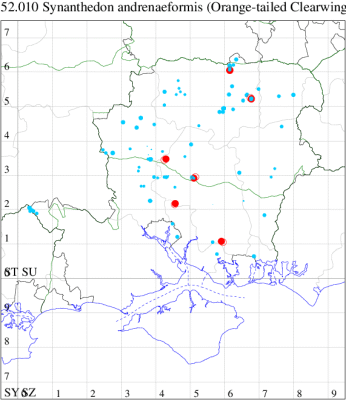
Records by year
Records by week (adult)
Records by week (larval)
Record Details
VC11: Romsey, five, to pheromone lure, 30 May (SC); Allbrook, three, to pheromone lure, 31 May; one, to pheromone lure, 07 Jun; one, to pheromone lure, to VES lure, 13 Jun (SI); Wickham Common, one, 20 Jun (DAS);
VC12: Crawley, one, to pheromone lure, to VES lure, 26 May; one, to pheromone lure, to VES lure, 28 May; four, to pheromone lure, to VES lure, 15 Jun (TNo); Magdalen Hill Down NR, two, 12 Jun (DAS); Mapledurwell Fen HIWWT, two, to pheromone lure, to VES lure, 17 Jun; Pamber Forest, one, to pheromone lure, 28 May (GJD)
52.011 [B&F: 0379] Red-belted Clearwing Synanthedon myopaeformis (Borkhausen, 1789) - Nb
Nationally scarce (Nb) in orchards, gardens, hedgerows, open woodland and scrub in southern England, northwards to Yorkshire, and north Wales. In Hampshire an essentially garden or suburban species, colonies often affecting a single apple tree, and has been attracted to pheromone lure in several localities. Not recorded from the Isle of Wight to date. Wingspan 15-22 mm. Day-flying. The early stages may be sought during the winter months, but the use of synthetic pheromone lures used to attract males has led to a marked increase in records of the species in recent years. Larva feeds within bark of Apple, Rowan, Pear and Almond.
Records prior to 2020
| Vice County | #Records | #Individuals | First Record | Last Record |
|---|---|---|---|---|
| 11 | 95 | 187 | 1900 | 2019 |
| 12 | 50 | 99 | 1961 | 2019 |
2020 records
| Vice County | #Records | #Individuals | Max Quantity |
|---|---|---|---|
| 11 | 9 | 27 | 11 |
| 12 | 10 | 16 | 4 |
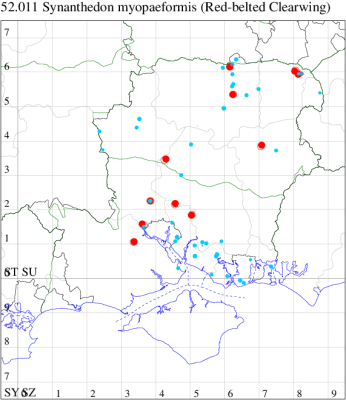
Records by year
Records by week (adult)
Records by week (larval)
Record Details
VC11: Ashurst, NF, one, to pheromone lure, 29 May; one, to pheromone lure, 15 Jun; one, to pheromone lure, 24 Jun (SAB); Nursling Substation, four, to pheromone lure, to MYO lure , also coming to CUL lure, 28 May (JClx); Romsey, 11, to pheromone lure, 21 May (SC); two, to pheromone lure, to CUL lure, 01 Jun (NRJ); Allbrook, two, to pheromone lure, 31 May; Fair Oak, three, to pheromone lure, to MYO lure, 24 Jun (SI);
VC12: Crawley, four, to pheromone lure, to CUL lure, 20 May; two, to pheromone lure, to MYO lure, 28 May (TNo); Basingstoke, one, field observation, 12 Jun (PEH); Pamber Forest, one, to pheromone lure, to CUL lure, 21 May (GJD); Pamber Heath, one, to pheromone lure, 26 May (PCus); Alton, one, to pheromone lure, 20 May (BCA); Yateley Common, two, to pheromone lure, to CUL lure, 25 May; Yateley*, two, field observation, attracted to CUL lure, 20 May (JHH); one, to pheromone lure, 21 Jun (GHa)
52.012 [B&F: 0374] Yellow-legged Clearwing Synanthedon vespiformis (Linnaeus, 1761) - Nb
Nationally scarce (Nb) in open woodland, parks and hedgerows in central southern England northwards to Yorkshire; occasionally locally common in gardens and on allotments. Probably under-recorded in Hampshire and on the Isle of Wight, where the extent of known records correlate with those areas in which the recording effort is concentrated. Wingspan 17-24 mm. Day-flying, occasionally seen in flight in woodland where oak trees have been felled. The early stages may be sought during the winter months, but synthetic pheromone lures are used to attract males nowadays, and this has led to a marked increase in records of the species in recent years. Larva feeds in the bark of Oak, Silver Birch, Downy Birch, Wych Elm and English Elm; larval workings may sometimes be found in abundance between the bark and wood of one-year-old oak stumps.
Records prior to 2020
| Vice County | #Records | #Individuals | First Record | Last Record |
|---|---|---|---|---|
| 10 | 20 | 7 | 1906 | 2017 |
| 11 | 52 | 60 | 1900 | 2019 |
| 12 | 60 | 88 | 1800 | 2019 |
2020 records
| Vice County | #Records | #Individuals | Max Quantity |
|---|---|---|---|
| 11 | 16 | 25 | 4 |
| 12 | 3 | 3 | 1 |
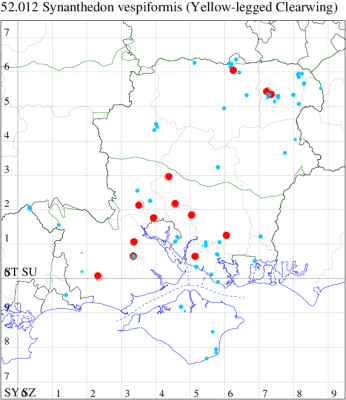
Records by year
Records by week (adult)
Records by week (larval)
Record Details
VC11: Holmsley, NF, one, to pheromone lure, 12 Jul (PDB); Denny Wood, NF, larva, one, field observation, 22 May (SFo); Ashurst, NF*, one, to pheromone lure, 21 May; one, to pheromone lure, 22 Jul (SAB); Lordswood, Southampton*, two, to pheromone lure, to VES lure , 07 Jul (JClx); Romsey, one, to pheromone lure, 18 Jul (SC); Crab Wood, Winchester, one, 20 Jun; four, 26 Jun (DAS); Allbrook, one, to pheromone lure, to VES lure, 14 Jun; two, to pheromone lure, 12 Jul (SI); Locks Heath, one, indoors, 15 Sep (PAS); Fair Oak, two, to pheromone lure, to VES lure, 14 Jul (SI); West Walk*, three, to pheromone lure, 07 Jun (GRE);
VC12: Pamber Forest, one, to pheromone lure, 13 Jul (GJD); Hook, one, to pheromone lure, to VES lure, 16 Jul; Bartley Heath, one, to pheromone lure, to VES lure, 07 Jul (PAV)
52.013 [B&F: 0373] Currant Clearwing Synanthedon tipuliformis (Clerck, 1759) - Nb
Nationally scarce (Nb) in gardens, farmland, market gardens and allotments in southern England northwards to Aberdeenshire, and north and south Wales (MBGBI Vol 2). In Hampshire and on the Isle of Wight there are clusters of records in and around Portsmouth and Gosport; in recent years, increasingly reported elsewhere in the county and on the Island. Wingspan 17-20 mm. Day-flying, the moth flying in sunshine over currant bushes Ribes. The early stages may be sought during the winter months, but synthetic pheromone lures are now used to attract males nowadays, and this has led to a marked increase in records of the species in recent years. Larva feeds within stems of Black Currant, Red Currant and Gooseberry.
Records prior to 2020
| Vice County | #Records | #Individuals | First Record | Last Record |
|---|---|---|---|---|
| 10 | 12 | 5 | 1856 | 2015 |
| 11 | 82 | 180 | 1900 | 2019 |
| 12 | 49 | 86 | 1951 | 2019 |
2020 records
| Vice County | #Records | #Individuals | Max Quantity |
|---|---|---|---|
| 11 | 3 | 3 | 1 |
| 12 | 2 | 2 | 1 |
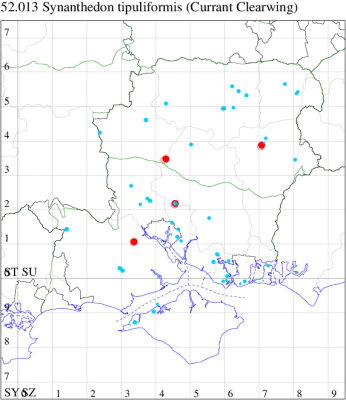
Records by year
Records by week (adult)
Records by week (larval)
Record Details
VC11: Ashurst, NF*, one, to pheromone lure, 15 Jun (SAB); Allbrook, one, to pheromone lure, to TIP lure, 13 Jun (SI);
VC12: Crawley*, one, to pheromone lure, to TIP lure, 27 May (TNo); Alton, one, to pheromone lure, 21 May (BCA)
52.014 [B&F: 0382] Six-belted Clearwing Bembecia ichneumoniformis ([Denis & Schiffermüller], 1775) - Nb
Nationally scarce (Nb) on chalk and limestone grassland, downland, embankments and quarries in southern England, south Wales and east Yorkshire. Fairly widely distributed mainly on downland across Hampshire, and mainly along the south coast in the Isle of Wight. Wingspan 15-21 mm. Unmistakable. Day-flying, sometimes found nectaring by day but most frequently encountered as a visitor to pheromone lure. Larva feeds within roots of Bird's-foot Trefoil and Kidney Vetch.
Records prior to 2020
| Vice County | #Records | #Individuals | First Record | Last Record |
|---|---|---|---|---|
| 10 | 86 | 228 | 1856 | 2019 |
| 11 | 115 | 731 | 1951 | 2019 |
| 12 | 83 | 562 | 1951 | 2019 |
2020 records
| Vice County | #Records | #Individuals | Max Quantity |
|---|---|---|---|
| 10 | 1 | 15 | 15 |
| 11 | 8 | 11 | 2 |
| 12 | 3 | 3 | 1 |
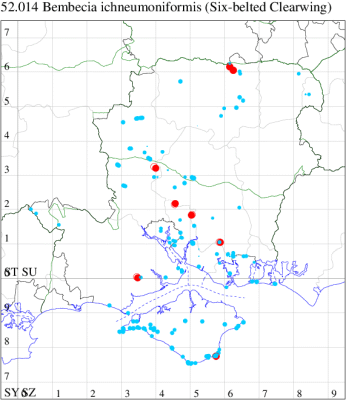
Records by year
Records by week (adult)
Records by week (larval)
Record Details
VC10: Wheelers Bay, 15, 24 Jun (IOu);
VC11: Beaulieu Heath, Lymington, present, field observation, 14 Jul (PCol); Up Somborne Down, two, to pheromone lure, to API lure, 22 Jun (TNo); Allbrook, one, to pheromone lure, to API lure, 31 Jul; Fair Oak, one, to pheromone lure, to API lure, 25 Jun (SI); Wickham Common, two, to pheromone lure, 30 Jul (KC);
VC12: Winchester, one, field observation, 08 Jun (iNat); Pamber Forest, one, to pheromone lure, to API lure, 16 Jul; one, to pheromone lure, to API lure, 16 Jul (GJD)
52.016 [B&F: 0383] Thrift Clearwing Pyropteron muscaeformis (Esper, 1783) - Nationally Scarce
Nationally scarce (Nb) along sea cliffs and rocky coasts in parts of south-western England, Wales and eastern Scotland, predominantly coastal. A sighting at Needs Ore in 2020 was a surprise - unfortunately there is no photo but the observers had no doubt of the identity being familiar with the species. Wingspan 15-18 mm. Day-flying. The moths fly in June and July, when they can be found on flowers of the foodplant as well as on Thyme; they also come to pheromone lure. Larva feeds within the roots and crowns of Thrift.
Records prior to 2020
| Vice County | #Records | #Individuals | First Record | Last Record |
|---|
2020 records
| Vice County | #Records | #Individuals | Max Quantity |
|---|---|---|---|
| 11 | 1 | 1 | 1 |
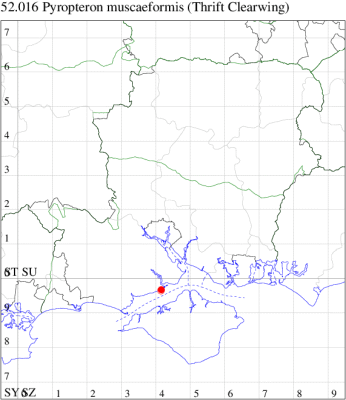
Records by year
Records by week (adult)
Records by week (larval)
Record Details
VC11: New Vice-county Record: Needs Ore*, one, field observation, 14 Jun (ACl, PS)
(to FOR lure)().jpg)
(to SAL lure)().jpg)